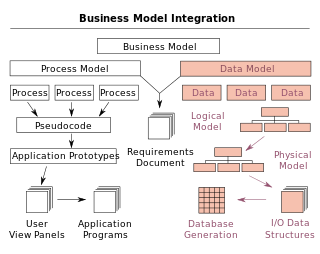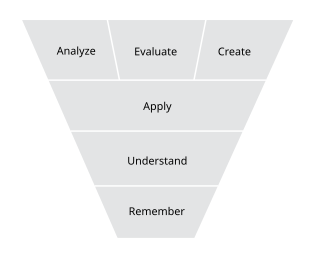
In computing, a database is an organized collection of data or a type of data store based on the use of a database management system (DBMS), the software that interacts with end users, applications, and the database itself to capture and analyze the data. The DBMS additionally encompasses the core facilities provided to administer the database. The sum total of the database, the DBMS and the associated applications can be referred to as a database system. Often the term "database" is also used loosely to refer to any of the DBMS, the database system or an application associated with the database.
Systems theory is the transdisciplinary study of systems, i.e. cohesive groups of interrelated, interdependent components that can be natural or artificial. Every system has causal boundaries, is influenced by its context, defined by its structure, function and role, and expressed through its relations with other systems. A system is "more than the sum of its parts" when it expresses synergy or emergent behavior.

A data model is an abstract model that organizes elements of data and standardizes how they relate to one another and to the properties of real-world entities. For instance, a data model may specify that the data element representing a car be composed of a number of other elements which, in turn, represent the color and size of the car and define its owner.
Bloom's taxonomy is a framework for categorizing educational goals, developed by a committee of educators chaired by Benjamin Bloom in 1956. It was first introduced in the publication Taxonomy of Educational Objectives: The Classification of Educational Goals. The taxonomy divides learning objectives into three broad domains: cognitive (knowledge-based), affective (emotion-based), and psychomotor (action-based), each with a hierarchy of skills and abilities. These domains are used by educators to structure curricula, assessments, and teaching methods to foster different types of learning.

IDEF, initially an abbreviation of ICAM Definition and renamed in 1999 as Integration Definition, is a family of modeling languages in the field of systems and software engineering. They cover a wide range of uses from functional modeling to data, simulation, object-oriented analysis and design, and knowledge acquisition. These definition languages were developed under funding from U.S. Air Force and, although still most commonly used by them and other military and United States Department of Defense (DoD) agencies, are in the public domain.

Data modeling in software engineering is the process of creating a data model for an information system by applying certain formal techniques. It may be applied as part of broader Model-driven engineering (MDE) concept.
Enterprise architecture (EA) is a business function concerned with the structures and behaviours of a business, especially business roles and processes that create and use business data. The international definition according to the Federation of Enterprise Architecture Professional Organizations is "a well-defined practice for conducting enterprise analysis, design, planning, and implementation, using a comprehensive approach at all times, for the successful development and execution of strategy. Enterprise architecture applies architecture principles and practices to guide organizations through the business, information, process, and technology changes necessary to execute their strategies. These practices utilize the various aspects of an enterprise to identify, motivate, and achieve these changes."
Social position is the position of an individual in a given society and culture. A given position may belong to many individuals.

Integration DEFinition for information modeling (IDEF1X) is a data modeling language for the development of semantic data models. IDEF1X is used to produce a graphical information model which represents the structure and semantics of information within an environment or system.

Higher-order thinking, also known as higher order thinking skills (HOTS), is a concept applied in relation to education reform and based on learning taxonomies. The idea is that some types of learning require more cognitive processing than others, but also have more generalized benefits. In Bloom's taxonomy, for example, skills involving analysis, evaluation and synthesis are thought to be of a higher order than the learning of facts and concepts using lower-order thinking skills, which require different learning and teaching methods. Higher-order thinking involves the learning of complex judgmental skills such as critical thinking and problem solving.
Jonathan Hey is an expert in connecting the abstract concepts of knowledge management with other levels of experiences like language and sensual interaction with the physical world, thus providing not only better understanding of these concepts but key elements of their more precise definition as well. This also enables experts in other fields than information science to incorporate understanding of those abstract levels into their own research.

The structure of observed learning outcomes (SOLO) taxonomy is a model that describes levels of increasing complexity in students' understanding of subjects. It was proposed by John B. Biggs and Kevin F. Collis.
Knowledge retrieval seeks to return information in a structured form, consistent with human cognitive processes as opposed to simple lists of data items. It draws on a range of fields including epistemology, cognitive psychology, cognitive neuroscience, logic and inference, machine learning and knowledge discovery, linguistics, and information technology.

Information is an abstract concept that refers to something which has the power to inform. At the most fundamental level, it pertains to the interpretation of that which may be sensed, or their abstractions. Any natural process that is not completely random and any observable pattern in any medium can be said to convey some amount of information. Whereas digital signals and other data use discrete signs to convey information, other phenomena and artifacts such as analogue signals, poems, pictures, music or other sounds, and currents convey information in a more continuous form. Information is not knowledge itself, but the meaning that may be derived from a representation through interpretation.

The three-schema approach, or three-schema concept, in software engineering is an approach to building information systems and systems information management that originated in the 1970s. It proposes three different views in systems development, with conceptual modelling being considered the key to achieving data integration.

A semantic data model (SDM) is a high-level semantics-based database description and structuring formalism for databases. This database model is designed to capture more of the meaning of an application environment than is possible with contemporary database models. An SDM specification describes a database in terms of the kinds of entities that exist in the application environment, the classifications and groupings of those entities, and the structural interconnections among them. SDM provides a collection of high-level modeling primitives to capture the semantics of an application environment. By accommodating derived information in a database structural specification, SDM allows the same information to be viewed in several ways; this makes it possible to directly accommodate the variety of needs and processing requirements typically present in database applications. The design of the present SDM is based on our experience in using a preliminary version of it. SDM is designed to enhance the effectiveness and usability of database systems. An SDM database description can serve as a formal specification and documentation tool for a database; it can provide a basis for supporting a variety of powerful user interface facilities, it can serve as a conceptual database model in the database design process; and, it can be used as the database model for a new kind of database management system.
The following outline is provided as an overview of and topical guide to knowledge:
Text and conversation is a theory in the field of organizational communication illustrating how communication makes up an organization. In the theory's simplest explanation, an organization is created and defined by communication. Communication "is" the organization and the organization exists because communication takes place. The theory is built on the notion, an organization is not seen as a physical unit holding communication. Text and conversation theory puts communication processes at the heart of organizational communication and postulates, an organization doesn't contain communication as a "causal influence", but is formed by the communication within. This theory is not intended for direct application, but rather to explain how communication exists. The theory provides a framework for better understanding organizational communication.

Milan Zeleny was a Czech-American economist, a professor of management systems at Fordham University, New York City. He has done research in the field of decision-making, productivity, knowledge management, and business economics. Zeleny was also a visiting professor at the Tomas Bata University in Zlín, Czech Republic, and has been academic vice dean and professor at Xidian University in Xi’an, China. He was a distinguished visiting professor at Fu Jen Catholic University in Taipei in 2006, at the Indian Institute of Technology in Kanpur in 2007, and at IBMEC in Rio de Janeiro in 2009–10. For many years he has lectured at the Faculty of Architecture, University of Naples.
Knowledge as a service (KaaS) is a computing service that delivers information to users, backed by a knowledge model, which might be drawn from a number of possible models based on decision trees, association rules, or neural networks. A knowledge as a service provider responds to knowledge requests from users through a centralised knowledge server, and provides an interface between users and data owners.














